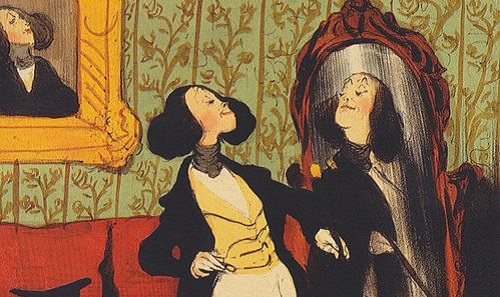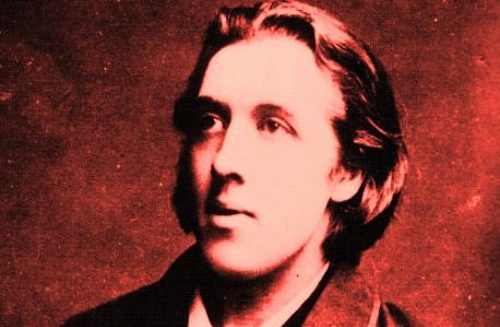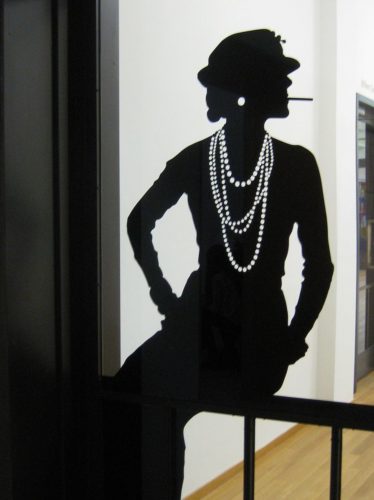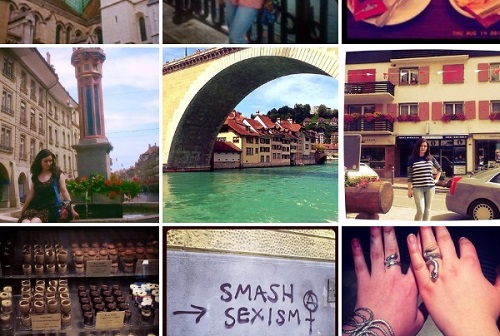
Spent all day looking at art (by Daumier) | Image: Wikimedia Commons
The author of the poem “Candy is dandy but liquor is quicker” got it all wrong: any self-respecting dandy would agree that liquor trumps candy when it comes to “dandiness.” So does sartorial elegance, quick-witted banter, and quoting “The Flowers of Evil”, probably.
But the elusive images of exclusive gentlemen clubs, smoky salons, and top hats hide, or at least disguise, the true definition of a dandy. Let us then embark on the noble quest of defining, identifying, and maybe seeking out the modern version of such a rare breed. Who were or even are dandies? On whose side are they?
Table of Contents
The Birth of a Myth
Finding out the origins of the heroes of our quest requires a brief time travel to London in the late 18th century. If we’re careful to avoid the horse carriages, we may be lucky enough to make Sir Beau Brummell’s acquaintance, and he will tell us everything he knows about the topic while smoking a cigar in his decorous apartment, probably.
Dandies, he’ll sure say, never come from upper classes. Those in the ups, lords and such, think their lifestyle ordinary and, so, pay little attention to the lavish beauty of art or exquisite mastery of their cooks. They need someone from the middle class, an intelligent loner, to show them the pleasures of a beautiful life.
Dandies appeared at the crossroads of the end of aristocracy and the birth of democracy. They came to define the “new” aristocracy: reminiscent of the English ideas about the perfect gentleman, yet with no blue blood to back it up. Dandyism is a cult of a person, not background. If you’re more amusing than the prince, who cares if your father is merely a politician, am I right? (Brummell is smirking, probably.)
The Dandy Evolution
“Dandyism is the aesthetic form of nihilism.” – Jean Baudrillard
After Beau hints that it is time for you to leave (as it is time for his boots to be polished with champagne), don’t ask amateur questions: a proper dandy is always an eccentric myth. They could be guest lecturers in any Public Relations class. Dandyism is a flirtatious relationship with the public: the right amount of societal scandal or juicy rumors keep the passion alive.
Oscar Wilde gave actress Lillie Langtry a lily every day – as a play on her name – and didn’t get offended at the papers for calling him foolish. He knew the Gossip Girl motto before it was the Gossip Girl motto: you’re no one until you’re talked about.
We’re leaving Brummell’s apartment to pay a visit to 19th century Paris, where the “second wave” of dandyism occurred, and invited Baudelaire to be our guide. Closer to bohemian ideas, Parisian dandies made beauty and art, rather than manners into a cult. Vulgarity was the enemy and simplicity the ultimate sophistication. The Baudelairian dandy is too narcissistic to ever fall in love with another person. He’s too busy reading Byron or turning his life into art.

“Gave a lily a day. Still friendzoned. Not bitter. I’m awesome.” – Oscar, probably | Photo: Wikimedia Commons
The third and final stage of dandyism is commercial, marketable. While the original dandies valued emotional reserve and calmness, the likes of Oscar Wilde found beauty in the artificial and the exaggerated – a suffocating perfume or flamboyant colors.
Susan Sontag describes this as a phenomenon called “Camp:” a show of coded messages for the “knowing” crowd and carnival masks that have on/off modes. This ironic stage of dandyism then dissipated into the sweet monstrousness of decadence.
On Gender and Fashion
Dandies were obsessed with “the other.” Everything French was considered most fashionable in England and, of course, vice versa. Mr. Wilde called his infamous infatuation with Lord Alfred a consequence of his love for paradoxes applied to the world of emotions. The paradoxes of gender have always been an essential part of dandyism.
A man spending five hours daily on his appearance seems feminine, while dandy women have always preferred masculine clothes. “The most womanly woman,” (according to Musset), George Sand, dressed in drag to go on fashionable (at the time) strolls around Paris without attracting unwanted attention.

“Orange is the new nothing. Black is the new black.” – Coco, probably | Photo: Wikimedia Commons
Coco Chanel, the dandiest woman of the fashion world (according, well, to me), was inspired by traditional English gentlemen costumes and the dandyism principle of “conspicuous inconspicuousness.” She advised her clients to “dress like their maids” and changed the meaning of black from mourning to chic.
Chanel was also the first one to accidentally set a trend. After a geyser explosion, she had to cut her slightly-burnt hair short, which caused a heated discussion at the opera and hundreds of haircuts. Like a true dandy, she valued an air of carelessness and comfort in fashion.
Oscar Wilde, too, took part in fashion revolutions. In contrast to Coco, he liked purple, gold, and ornamental details, but the general principle of “functional chic” still stands: he actively supported Dress Reform, an 1880 women’s movement against corsets and high heels.
Throughout history dandies have pioneered many fashion trends and movements – changing tastes from impeccable simplicity to much-discussed eccentricity and back again – but their fashion has always been just another aspect of the personality cult.
Spot the Dandy
So, where is (s)he, the modern dandy? Maybe what’s left is a Halloween costume idea, an anachronism, a dream, a joke? Maybe we can find only pieces of the image, or read fashionable novels to recreate the pseudo-good old days of dandy clubs and narcissistic romance.

Or, could it be that dandies are all around us? Those who wear ideas pulled right from the runways or their imaginations, who turn their whole life into a piece of art in an Instagram-mosaic of only the dandiest pieces.
The emotional walls and self-admiration in selfies, the cult of beauty, the cult of vulgarity, exaggeration, masks, Camps, gender benders, and more personal blogs than people on the planet. Dandyism is in full swing. Yet no one is the audience.
Thoughts?
Who is the modern dandy? Are you one (even slightly)? Is modern dandyism going to end in decadence as well? Tell us what you think in the comments.

I like macaronis more
(oh, btw, I’m an english major/ writing nerd)